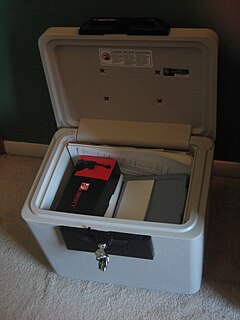BS 5454, "Recommendations for the storage and exhibition of archival documents" was a British Standard for the construction of building repositories for archive collections. It specified security standards, fire resistance, structural qualities for document storage buildings and their locations, environmental parameters (temperature and humidity ranges) designed to protect documents, shelving schemes, and materials for document containers. It was withdrawn in 2012, being replaced by BSI PD 5454:2012 Guide for the Storage and Exhibition of Archival Materials. PD 5454 was a temporary Guide, used as a 'stop-gap' while a new CEN standard was being developed. The new standard, EN 16893:2018 replaced PD 5454 and the latter was also withdrawn. The full title of EN 16893:2018 is Conservation of Cultural Heritage - Specifications for location, construction and modification of buildings or rooms intended for the storage or use of heritage collections.
For archival and library collections (the original sector at which 5454 was aimed), a reviewed standard, BS 4971, was released in 2017. EN 16893 focused on the qualities of planning and construction of a building intended to hold heritage collections of all forms (so not just archives) and as such does not hold environmental requirements for any specific heritage. To ensure continuity in the UK, where archive and library professionals had been used to using the old 5454 as a source for specific environmental requirements, BS 4971 was changed to cover those environmental parameters. The language of EN 16893 and its environmental requirements push the sector towards ceasing to use HVAC systems for environmental control and instead to commission storage construction to be air-tight and thermally stable and thereby provide very slow changing humidity conditions seasonally without the need for HVAC systems which, over the decades since BS 5454:1989, had proven to be a failure at protecting collections. BS 4971:2017 Conservation and care of archive and library collections takes the same approach and references EN 16893 for construction qualities.
The fire, water and security resistance qualities of buildings containing all heritage forms are now covered in EN 16893, as in the old BS 5454, but reviewed and updated. The new standard also takes over the planning and decision-making elements from another BS Guide, PAS 198:2012, promoting a risk-assessment approach to defining the protective qualities of heritage stores and display or reading spaces.

British Standards (BS) are the standards produced by the BSI Group which is incorporated under a royal charter and which is formally designated as the national standards body (NSB) for the UK. The BSI Group produces British Standards under the authority of the charter, which lays down as one of the BSI's objectives to:
Set up standards of quality for goods and services, and prepare and promote the general adoption of British Standards and schedules in connection therewith and from time to time to revise, alter and amend such standards and schedules as experience and circumstances require.

Heating, ventilation, and air conditioning (HVAC) is the technology of indoor and vehicular environmental comfort. Its goal is to provide thermal comfort and acceptable indoor air quality. HVAC system design is a subdiscipline of mechanical engineering, based on the principles of thermodynamics, fluid mechanics and heat transfer. "Refrigeration" is sometimes added to the field's abbreviation, as HVAC&R or HVACR or "ventilation" is dropped, as in HACR.

Business continuity may be defined as "the capability of an organization to continue the delivery of products or services at pre-defined acceptable levels following a disruptive incident”, and business continuity planning is the process of creating systems of prevention and recovery to deal with potential threats to a company. In addition to prevention, the goal is to enable ongoing operations before and during execution of disaster recovery. Business continuity is the intended outcome of proper execution of both business continuity planning and disaster recovery.

A safe is a secure lockable box used for securing valuable objects against theft and/or damage from fire. A safe is usually a hollow cuboid or cylinder, with one face being removable or hinged to form a door. The body and door may be cast from metal or formed out of plastic through blow molding. Bank teller safes typically are secured to the counter, have a slit opening for dropping valuables into the safe without opening it, and a time-delay combination lock to foil robbers/and or thieves. One significant distinction between types of safes is whether the safe is secured to a wall or structure or if it can be moved around. A less secure version is usually called a cash-box.
The conservation and restoration of photographs is the study of the physical care and treatment of photographic materials. It covers both efforts undertaken by photograph conservators, librarians, archivists, and museum curators who manage photograph collections at a variety of cultural heritage institutions, as well as steps taken to preserve collections of personal and family photographs. It is an umbrella term that includes both preventative preservation activities such as environmental control and conservation techniques that involve treating individual items. Both preservation and conservation require an in-depth understanding of how photographs are made, and the causes and prevention of deterioration. Conservator-restorers use this knowledge to treat photographic materials, stabilizing them from further deterioration, and sometimes restoring them for aesthetic purposes.

In library and archival science, preservation is a set of preventive conservation activities aimed at prolonging the life of a record, book, or object while making as few changes as possible. Preservation activities vary widely and may include monitoring the condition of items, maintaining the temperature and humidity in collection storage areas, writing a plan in case of emergencies, digitizing items, writing relevant metadata, and increasing accessibility. Preservation, in this definition, is practiced in a library or an archive by a librarian, archivist, or other professional when they perceive a record is in need of maintenance.

The conservation and restoration of parchment constitutes the care and treatment of parchment materials which have cultural and historical significance. Typically undertaken by professional book and document conservators, this process can include preventive measures which protect against future deterioration as well as specific treatments to alleviate changes already caused by agents of deterioration.
Wiltshire and Swindon History Centre is a building in Chippenham, Wiltshire, England, which serves as a focal point for heritage services relating to Wiltshire and Swindon. It is funded by Wiltshire Council and Swindon Borough Council. It has purpose-built archive storage and research facilities and incorporates the local studies library, museums service, archaeology service, Wiltshire buildings record and the conservation service. These services were formerly housed in separate locations in Trowbridge and Salisbury and are now together under one roof. The centre opened to the public on 31 October 2007 and is being marketed as a "passport to the past" for those interested in Wiltshire and Swindon history.
A specification often refers to a set of documented requirements to be satisfied by a material, design, product, or service. A specification is often a type of technical standard.

Mold control and prevention is a conservation activity that is performed in libraries and archives to protect books, documents and other materials from deterioration caused by mold growth. Mold prevention consists of different methods, such as chemical treatments, careful environmental control, and manual cleaning. Preservationists use one or a combination of these methods to combat mold spores in library and archival collections.

The Church History Library (CHL) is a research center and archives building housing materials chronicling the history of The Church of Jesus Christ of Latter-day Saints. The library is owned by the LDS Church and opened in 2009 in downtown Salt Lake City, Utah.
In the United Kingdom the term county record office usually refers to a local authority repository, also called a county archives.

Collections management involves the development, storage, and preservation of cultural property, as well as objects of contemporary culture in museums, libraries, archives and private collections. The primary goal of collections management is to meet the needs of the individual collector or collecting institution's mission statement, while also ensuring the long-term safety and sustainability of the cultural objects within the collector's care. Collections management, which consists primarily of the administrative responsibilities associated with collection development, is closely related to collections care, which is the physical preservation of cultural heritage. The professions most influenced by collections management include collection managers, registrars, and archivists.

The conservation and restoration of books, manuscripts, documents and ephemera is an activity dedicated to the preservation and protection of items of historical and personal value made primarily from paper, parchment, and leather. When applied to cultural heritage, conservation activities are generally undertaken by a conservator. The primary goal of conservation is to preserve the lifespan of the object as well as maintaining its integrity by keeping all additions reversible. Conservation of books and paper involves techniques of bookbinding, restoration, paper chemistry, and other material technologies including preservation and archival techniques.
Integrated pest management in museums, libraries, archives and private collections is the practice of monitoring and managing pest and environmental information with pest control methods to prevent pest damage to collections and cultural property. Preserving cultural property is the ultimate goal for these institutions. The pests come in many different forms: insects, mites, rodents, bats, birds, and fungi and the two most common types are insects and fungi. It is widely recommended that every museum have some form of pest control in place and monitoring system to protect their collection and that museums review their storage and museum facilities to determine how to best control and prevent pest infestations while utilizing an Integrated Pest Management plan.

Cyprus Organisation for Standardisation or CYS, is the National Standardisation Body of Cyprus, whose principal activity is the production of standards and the supply of standards-related services.

The conservation and restoration of paintings is carried out by professional painting conservators. Paintings cover a wide range of various mediums, materials, and their supports. Painting types include fine art to decorative and functional objects spanning from acrylics, frescoes, and oil paint on various surfaces, egg tempera on panels and canvas, lacquer painting, water color and more. Knowing the materials of any given painting and its support allows for the proper restoration and conservation practices. All components of a painting will react to its environment differently, and impact the artwork as a whole. These material components along with collections care will determine the longevity of a painting. The first steps to conservation and restoration is preventive conservation followed by active restoration with the artist's intent in mind.
The conservation and restoration of film is the physical care and treatment of film-based materials. These include photographic film and motion picture film stock.

The 'ten agents of deterioration' are a conceptual framework developed by the Canadian Conservation Institute (CCI) used to categorise the major causes of change, loss or damage to cultural heritage objects. Also referred to as the 'agents of change', the framework was first developed in the late 1980s and early 1990s. The defined agents reflect and systematise the main chemical and physical deterioration pathways to which most physical material is subject. They are a major influence on the applied practice of conservation, restoration, and collection management, finding particular use in risk management for cultural heritage collections.
Temperature, humidity, light, atmospheric pollutants and dust are typically controlled in buildings that contain collections of cultural and scientific significance. These environmental factors are all 'agents of deterioration' that cause damage to objects, as they play a role in deterioration pathways such as oxidation, hydrolysis, cross-linking and chain scission.